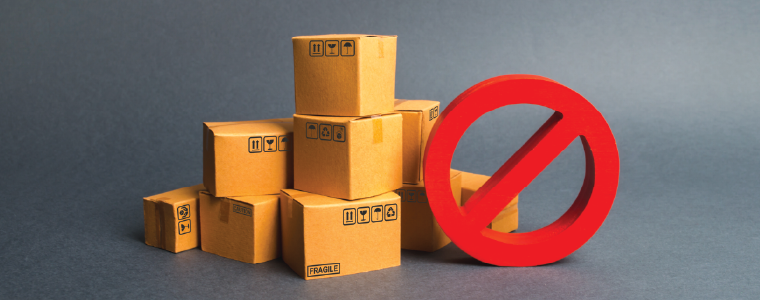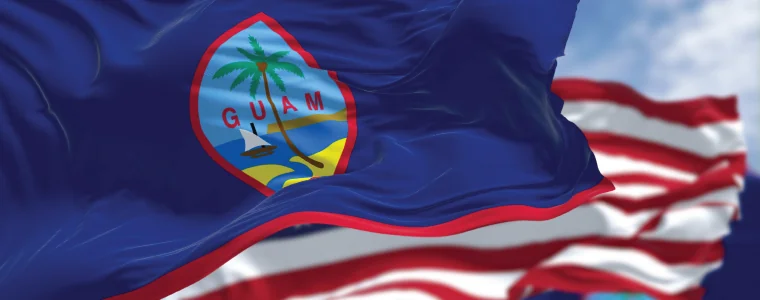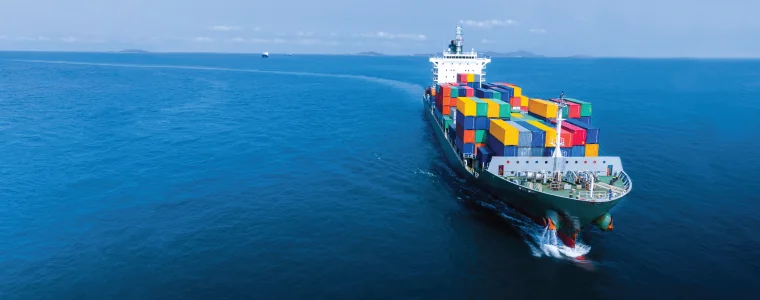If you’re new to Guam freight shipping, you might not realize that Guam freight is subject to a different set of customs regulations than the continental U.S.
The Guam Customs and Quarantine Agency (CQA) oversees and enforces all of Guam’s import regulations. If you’re sending freight to Guam, you need to comply with the CQA’s regulations, procedures, import taxes, and shipping restrictions.

“For businesses moving goods, supplies, and materials to Guam, understanding the ins and outs of Guam freight customs clearance is essential,” notes John Burrows, CEO of DeWitt Guam. “Missteps in documentation, compliance, or tax calculations can lead to delays or even fines.”
In this guide, you’ll find a comprehensive, step-by-step breakdown of Guam’s customs regulations to keep your shipments compliant—and free of prohibited items—to minimize costs and delays.
If you have any additional questions, John suggests reaching out to the Tamuning-based DeWitt Guam team.
“After processing tens of thousands of shipments arriving to Guam, we know exactly how to keep freight moving to its final destination on Guam,” he shared. “We have on-the-ground resources to assist, and we can work with the CQA on shippers’ behalf as a customs clearance broker. We also operate a Container Freight Station where shipments flagged by customs can be held securely for inspection.”
In This Article:
- Required Documentation for Freight Customs Clearance
Customs Fees & Use Taxes on Guam Freight Shipments
- Guam Ocean Freight
- Guam Air Freight
- Guam Use Tax
- Customs Inspections
- Importing Firearms
- Importing Motorcycles and Watercraft
Restricted & Prohibited Items for Import to Guam
- How Can Guam Customs Brokers Help with Customs Clearance?
A Step-by-Step Guide to Clearing Customs for Guam Freight
- Step 1: Arrival
- Step 2: Customs Review
- Step 3: Potential Inspection
- Step 4: Freight Release
- Step 5: Freight Made Ready for Pickup or Delivery
Choosing Between Air Freight & Ocean Freight
- Guam Air Freight Pros & Cons
- Guam Ocean Freight Pros & Cons
Understanding Guam’s Customs Procedures for Freight Shipments

Despite being a U.S. territory, freight arriving to the island of Guam doesn’t fall under the jurisdiction of U.S. Customs and Border Protection (CBP). Instead, the island has its own customs authority, the Guam Customs and Quarantine Agency (CQA), which enforces Guam’s laws and import restrictions, as well as collects customs fees and use tax.
Before we take a comprehensive look at Guam’s freight customs procedures, a few highlights for you to be aware of:
- Before importing goods, supplies, or materials, make sure you’ve obtained a business license from the Guam Department of Revenue and Taxation.
- To avoid delays, work closely with your freight provider to assemble the correct documentation to accompany your shipment, including a commercial invoice.
- For items not intended for resale, Guam imposes a 4% use tax on all items imported for business use. Use tax is calculated on the value of the commodity shipped, plus the cost of the ocean and/or air freight.
- Merchandise intended for sale is not subject to use tax. However, it will be subject to 4% gross receipts tax once it’s sold on Guam.
- Guam restricts the import of certain fruits, vegetables, and plant materials. Make sure to review the Guam Department of Agriculture regulations before importing live plants or agricultural material.
Required Documentation for Freight Customs Clearance
- Commercial Invoice – Provides details about the items imported, their value, and the seller/buyer information.
- Bill of Lading (BOL) or Air Waybill (AWB) – A shipping document issued by the carrier that serves as proof of shipment. Your Guam freight forwarder will handle this. It is best to ensure the BOL is arranged as telex released or sea waybill.
- Packing List – A document listing all items included in the shipment.
- Certificate of Origin
- Import Permit – Certain items imported to Guam will require an import permit. For example, live plants, cut flowers, fruit, vegetables, wood products, plant products, animal feed, seeds, etc. will require an import permit from the Guam Department of Agriculture. Check with your freight provider for any import permits required for your shipment.
If any of your documentation is missing or incorrect, your shipment may be delayed—or flagged for additional inspection.
Customs Fees & Use Taxes on Guam Freight Shipments
Guam customs fees are calculated based on the method you use to ship your freight, as well as its weight:
Guam Ocean Freight
The first 4,000 lbs. of sea cargo (including vehicles) will be assessed a $75.00 fee for domestic shipments and $125.00 for international shipments. A $0.0012 fee will be charged for every pound thereafter.
- If you send a freight shipment from California to Guam that weighs 5,000 lbs., you’d be charged customs fees of $75 + $1.20 (1,000 x $0.0012), or $76.20.
Guam Air Freight
The first 100 lbs. of air cargo will be assessed a $125.00 fee. A $0.0012 fee will be charged for every pound thereafter.
- If you send an air freight cargo shipment that totals 150 lbs., you’d be charged $125 + $0.06 (50 x $0.0012) or $125.06.
Guam Use Tax
If you’re importing items to be used or consumed by your business—i.e., not for resale—they will be subject to a 4% use tax. Use tax is based on the value of the commodity shipped, plus the cost of the ocean and/or air freight. This tax will be collected by the Guam CQA on arrival.
Customs Inspections
If the CQA holds any shipment for a physical exam, a fee of $75/hour for loose-loaded shipments or $50/crate for liftvan-loaded shipments will be assessed.
Importing Firearms
Shipments with firearms must be held in a certified Container Freight Station for inspection by Guam Customs prior to release. A fee of $1.00 per cubic foot will be assessed for the entire shipment. An import permit will be required.
Importing Motorcycles / Scooters / Mopeds / ATVs / Trailers / Watercraft
These items must be held in a certified Container Freight Station for inspection by Guam Customs prior to release. A fee of $1.00 per cubic foot will be assessed.
Additional Guam Taxes
- Gross Receipts Tax – Also called a “business privilege tax,” this 4% tax will be levied for any goods that are sold either retail or wholesale.
- Tobacco Tax – Businesses importing tobacco to Guam are subject to this excise tax, which varies depending on the form of the tobacco.
- Alcohol Tax – Excise tax is also levied on alcoholic beverages imported to and sold on Guam. (Those manufactured on Guam are exempt.) The tax varies based on the form of the alcoholic beverage—i.e., beer, liquor, and wine carry different taxes.
For more details on Guam’s tax laws, visit the website for the Guam Department of Revenue & Taxation.
Restricted & Prohibited Items for Import to Guam

Guam enforces strict shipping restrictions on prohibited items, meaning these items cannot enter Guam under any circumstances:
- Pornography and seditious documents
- Illegal drugs, including the raw materials and equipment involved in its manufacture
- Misbranded or adulterated food, drugs, medicines, of liquors
- Forged or counterfeit goods
Other items are restricted for import, including:
- Certain fruits, vegetables, and plant materials, as determined by the Guam Department of Agriculture
- Endangered species and artifacts
- Controlled substances, in compliance with Guam’s Uniform Controlled Substances Act
When in doubt about Guam import regulations, it’s best to ask your Guam freight forwarder up front to prevent any problems during customs inspection.
3 Tips for Avoiding Guam Customs Delays and Issues
- Verify all your documentation – Work closely with your Guam freight forwarder to ensure all your documentation is accurate and complete. Something as simple as a mismatch between a packing list and a commercial invoice could cause a customs delay.
- Double-check the declared value of your shipment – If customs officials perceive a mismatch between the declared value and the contents of the shipments, that can raise a red flag.
- Stay up to date on restricted & prohibited items – This will ensure you secure all necessary import permits well in advance, paving the way for smooth customs clearance.
How Can Guam Customs Brokers Help with Customs Clearance?
Guam customs brokers and customs clearance agents specialize in helping shipments clear customs procedures in Guam with minimal delays:
- Shippers may choose to work with a customs broker from the start to assist with filing freight documentation, calculating customs fees and taxes, obtaining import permits for restricted items, and vetting shipments for potential red flags.
- Or, if the CQA flags a shipment for further inspection, shippers can reach out to a Guam customs clearance broker to work directly with the CQA to resolve the issues delaying the shipment—paperwork, payments due, etc.
The DeWitt Guam team has decades of experience in successfully clearing freight shipments through customs. If you need custom clearance services for your Guam freight shipment, drop us a line.
A Step-by-Step Guide to Clearing Customs for Guam Freight

To help you better understand the Guam customs clearance process, we’ve put together a detailed breakdown for you:
Step 1:
Arrival of Goods to Guam
Once a shipment reaches Guam via air or ocean freight, it will be processed at one of the following entry points:
- Air freight: Antonio B. Won Pat International Airport (GUM)
- Ocean freight: Jose D. Leon Guerrero Commercial Port, also known as the Port of Guam
Step 2:
Customs Review
After arrival, all freight passes through Guam CQA customs clearance procedures. Customs officers will review the paperwork accompanying each shipment and review the associated 1) customs fees and 2) use tax, if applicable.
Incomplete or incorrect documentation can result in delays or additional inspections.
Step 3:
Potential Inspections
The CQA may decide to hold a shipment for further inspection to ensure compliance with import regulations. This might be a physical inspection, an X-ray scan, or an agricultural inspection. Freight may be moved to a Container Freight Station where the shipment can be stored and securely unpacked for CQA review.
Step 4:
Freight Released for Pickup
Once the CQA has completed their procedures, the freight will be released for pickup.
If you’re working with DeWitt Guam, our team will retrieve the freight from the seaport or airport.
Step 5:
Freight Made Ready for Pickup or Delivery
Your freight provider will then bring your freight back to their terminal for devanning/unpacking and make it available for pickup or delivery.
If you’re working with the DeWitt Guam team, we’d be happy to arrange delivery to any location on Guam.
Note: Customs Procedures Can Change
“In our experience, customs regulations can change at any time—without notice,” DeWitt Guam CEO John Burrows shared.
“Use the information in this article as a guide and contact your Guam freight provider or Guam customs broker for the most up-to-date regulations and fees. The DeWitt Guam team would be happy to help.”
Choosing Between Guam Air Freight & Ocean Freight

Finally, if you’re looking for a more information on the best way to get your freight to Guam, here’s a run-down on your two options: air freight and ocean freight.
Choosing the right option for your business depends on factors such as: How quickly do you need your freight to arrive? What’s your budget? And how big/heavy is your shipment?
Guam Air Freight Pros & Cons
- Fastest option – Typically, air freight can arrive on Guam in as little as 2-4 days.
- Higher cost – Air freight is significantly more expensive than ocean freight.
- Best for high-value, high-margin goods – Electronics, pharmaceuticals, and perishable items are all great candidates for air freight.
- Weight and size are a factor – Large and heavy shipments can be prohibitively expensive—and some are simply too heavy or too large to travel on a plane.
Guam Ocean Freight Pros & Cons
- Most economical shipping method – Ocean freight is the most budget-friendly option for most shipments.
- Fewer weight/size restrictions – If you’re shipping heavy or oversized items, ocean freight will be your best bet.
- Longer transit times – Port-to-port transit time from the U.S. West Coast is about two weeks. You’ll need to add on a few days on either end to account for cut-offs, loading and unloading time, as well as CQA clearance.
Simplifying Your Next Guam Freight Shipment
Understanding Guam freight customs clearance procedures is the first step toward simple, efficient shipments to the island. If you’re looking for a Guam-based freight provider to assist with your next shipment, reach out to the DeWitt Guam team.
We can assist with:
- Ocean freight (FCL/LCL)
- Air freight
- On-island trucking and delivery
- Guam customs clearance and Guam customs broker services
- Warehousing and distribution
- Storage, both here on Guam and through our mainland partners
We’d love to be your one-stop solution for your next Guam freight shipment.
